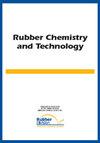ELECTROMAGNETIC ABSORPTION CHARACTERISTICS OF MANGANESE–ZINC FERRITE AND MULTIWALLED CARBON NANOTUBE–FILLED COMPOSITES BASED ON NBR
IF 1.5
4区 工程技术
Q4 POLYMER SCIENCE
引用次数: 0
Abstract
Composites based on acrylonitrile–butadiene rubber, carbon nanotubes, and manganese–zinc ferrite were fabricated and tested for electromagnetic interference (EMI) absorption shielding. First, carbon nanotubes and ferrite were solely used for the preparation of rubber composites. Then, carbon nanotubes were combined with magnetic filler and incorporated into the rubber matrix. The results revealed that carbon nanotubes act as reinforcing filler and significantly enhance the physical–mechanical properties of composites. The presence of carbon nanotubes in the rubber matrix also results in an outstanding increase in electrical conductivity and permittivity of composite materials, as a consequence of which the EMI absorption shielding was poor in the tested frequency range of 1 MHz to 3 GHz. On the other hand, ferrite-filled composites are able to efficiently absorb electromagnetic radiation emitted from various electronic and radiation sources. However, the tensile strength of the composites showed a decreasing trend with increasing content of ferrite. The combination of carbon nanotubes with manganese–zinc ferrite resulted in an improvement in the physical–mechanical properties of hybrid composites. As the permittivity of hybrid composites was still much higher in comparison with those filled only with ferrite, only the composite filled with 5 phr of carbon nanotubes and 100 phr of ferrite showed a slight EMI absorption shielding ability over the tested frequency range.基于NBR的锰锌铁氧体及多壁碳纳米管填充复合材料的电磁吸收特性
制备了丙烯腈-丁二烯橡胶、碳纳米管和锰锌铁氧体复合材料,并对其电磁干扰(EMI)吸收屏蔽性能进行了测试。首先,将碳纳米管和铁氧体单独用于制备橡胶复合材料。然后,将碳纳米管与磁性填料结合,并将其掺入橡胶基体中。结果表明,碳纳米管作为补强填料,能显著提高复合材料的物理力学性能。橡胶基体中碳纳米管的存在也导致复合材料的导电性和介电常数显著增加,因此在1 MHz至3 GHz的测试频率范围内,EMI吸收屏蔽效果较差。另一方面,铁氧体填充复合材料能够有效地吸收来自各种电子和辐射源的电磁辐射。随着铁素体含量的增加,复合材料的抗拉强度呈下降趋势。碳纳米管与锰锌铁氧体的结合使杂化复合材料的物理力学性能得到改善。由于杂化复合材料的介电常数仍远高于仅填充铁氧体的杂化复合材料,因此在测试频率范围内,只有填充5phr碳纳米管和填充100 phr铁氧体的杂化复合材料表现出轻微的电磁干扰吸收屏蔽能力。
本文章由计算机程序翻译,如有差异,请以英文原文为准。
求助全文
约1分钟内获得全文
求助全文
来源期刊

Rubber Chemistry and Technology
工程技术-高分子科学
CiteScore
3.50
自引率
20.00%
发文量
21
审稿时长
3.6 months
期刊介绍:
The scope of RC&T covers:
-Chemistry and Properties-
Mechanics-
Materials Science-
Nanocomposites-
Biotechnology-
Rubber Recycling-
Green Technology-
Characterization and Simulation.
Published continuously since 1928, the journal provides the deepest archive of published research in the field. Rubber Chemistry & Technology is read by scientists and engineers in academia, industry and government.
 求助内容:
求助内容: 应助结果提醒方式:
应助结果提醒方式:


